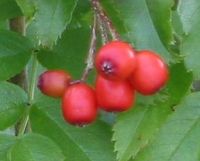Siberian Mountain-ash - Sorbus sambucifolia
English name:
Siberian Mountain-ash
Scientific name:
Sorbus sambucifolia
Family:
Rosaceae (Rose family)
Height:
Variable, 0.5 to 3 M in the Hørsholm Arboretum
Flowering:
early May
Range:
High Mountains in Japan, Russian Far East, Aleutian Islands
 |
 |
The 26 year-old Sorbus sambucifolia in the main picture is our largest specimen. It comes from seed collected by the Finish Amur Expedition in 1977near Susanino, Khabarovsk in Russias Far East. This bush is located on the south edge of the Arboretum parking lot: square 1117 position 1315.
Plant description:
The first fruits to ripen in our Arboretum often are on plants from cold climates with short growing seasons. One of these early plants, Sorbus sambucifolia, is feature this month. The rapid ripening of the fruit is probably a necessary adaptation to the short, cool growing seasons in its native habitats. The fruits of this species can be cooked or eaten raw. In spite of their palatability, they are not immediately eaten by birds, but stay on the bushes from the beginning of august until mid October according to our records. Sorbus sambucifolia does not occur in North America proper, but other species, for example S. decora and S. scopulina have been misidentified as it.
The genus Sorbus has a natural range is widespread in the northern hemisphere. Some species in this genus are notable for occurring at or above the tree line. Sorbus are often grown as garden and park plants, not for their flowers, but for their decorative fruit and bright autumn colours. Some are especially wind tolerant and are planted near coastal areas in Denmark. The fruit is used in making jellies and drinks, such as the locally well know aperitif, Gammel Dansk. The genus Sorbus is reported to have 193 species. We have 63 species of Sorbus registered as growing at Hørsholm, and 6 specimens of Sorbus sambucifolia.
Sorbus sambucifolia is reported to have been introduced into cultivation in the west in 1905. We received our first seed of Sorbus sambucifolia in 1963 but no plants exist from this date. Our oldest living plants are from 1977 and are grafts taken from plants collected by Th. Sørensen, on Sakhalin Island in Russia. They were donated by the Copenhagen Botanic Garden.
Sorbus sambucifolia is a short-lived, deciduous shrub up to 3 m in height. Plants from alpine areas or wind swept islands however, often are much lower in stature. The twigs are prominently covered with lenticels. The leaves are compound, with 9-11 coarsely toothed leaflets that are unequal at the base. The leaflets are shinny green above and slightly paler beneath. The flowers are white to pinkish, and not showy. They occur in an inflorescence of up to 10 flowers that tend to hang. The 1 cm wide fruits are oval and red or orange. The remains of the sepals can be seen on the tops of the fruits.
This is a rather rare Sorbus species in cultivation, but it is offered by at least one nursery in Denmark. It makes a fine garden plant for Denmark with deep green foliage, and decorative fruit from the end of July. The autumn leaf colours also add to its usefulness in the garden.
References:
Bean, W. J. 1980. Trees and shrubs hardy in the British Isles. Vol. IV Ri-Z. John Murray Pubs. Ltd. London. 808 pp.
Mabberley, D.J. 1998. The Plant Book. The Bath Press, Bath, 858 pp.
Ohwi, J. 1984. Flora of Japan (in English). Smithsonian Institution, Washington D.C. 1067 pp.
Rehder, A.1940. Manual of Cultivated Trees and Shrubs Hardy in North America. The Macmillan Co., New York. 996 pp.
